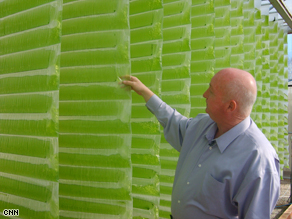
Posted on 12/26/2008 11:31:10 PM PST by neverdem
In pursuing cleaner energy there is such a thing as being too green. Unicellular microalgae, for instance, can be considered too green. In a paper in a special energy issue of Optics Express, the Optical Society's (OSA) open-access journal, scientists at the University of California, Berkeley describe a method for using microalgae for making biofuel. The researchers explain a way to genetically modify the tiny organisms, so as to minimize the number of chlorophyll molecules needed to harvest light without compromising the photosynthesis process in the cells. With this modification, instead of making more sugar molecules, the microalgae could be producing hydrogen or hydrocarbons.
Berkeley researchers have identified the genetic instructions in the algae genome responsible for deploying approximately 600 chlorophyll molecules in the cell's light-gathering antennae. They believe that the algae can get along with as few as 130 molecules. Basically the scientists want to divert the normal function of photosynthesis from generating biomass to making products such as lipids, hydrocarbons, and hydrogen.
Tasios Melis, one of the paper's co-authors, argues that the algae's chlorophyll antennae help the organisms compete for sunlight absorption and survive in the wild, where sunlight is often limited, but is detrimental to the engineering-driven effort of using algae to convert sunlight into biofuel.
Melis uses the phrase "cellular optics" to describe this general effort to maximize the efficiency of the solar-to-product conversion process. Besides getting the algae to convert more sunlight to fuel, another issue that needs to be addressed is how to configure bio-culture tanks in such a way that sunlight can penetrate the outer layer of algae so that lower-down layers can participate in the photo-conversion too.
Microalgae are ideal because of their high rate of photosynthesis; they are perhaps ten times more efficient in this than the land plants—such as sugarcane, corn, and switchgrass—often discussed as possible biofuel stocks.
How soon can algae play a role? According to Melis, "Progress is substantial to date, but not enough to make the process commercially competitive with fossil fuels. Further improvement in the performance of photosynthesis under mass culture conditions, and in the yield of "biofuels" by the microalgae are needed before a cost parity with traditional fuels can be achieved."
Source : Optical Society of America
4 later
Our unconscious brain makes the best decisions possible
Common infant virus may trigger type 1 diabetes
FReepmail me if you want on or off my health and science ping list.
Eventually the bio-fuel science/technology will arrive and compete with the rest of the energy sources: in about 15-20 years.
And my guess is that all we will need to complete the transition to a viable replacement for fossil fuel will be a small processing vat about the size of the gulf of Mexico.
The Green Slime that “appears” in our garden water features is capable of creating that “rainbow” oil-slick. It sure resembles “Oil, on water”.
We have 15-20 years to think smaller: think smaller box.
Eventually the bio-fuel science/technology will arrive and compete with the rest of the energy sources: in about 15-20 years.
................
I think it will be under 5 years.
Yes, perhaps on a small scale.
My time frame is more along the lines of competition for large scale energy re: oil, gas, coal, water, solar, wind....
we’ve got plenty of empty real estate in some parts of the Union.
The Klamath lakes in southeastern Oregon/Northeastern CA are naturally eutrophic. I was on a pier watching boast go by on the lake and the wake was like Pesto sauce.
Saying, “Further improvement in the performance of photosynthesis under mass culture conditions, and in the yield of “biofuels” by the microalgae are needed before a cost parity with traditional fuels can be achieved.”,
does severely understate the problems to be overcome.
Seems like it would be easier to find away to turn coal into gas at a lower cost Hitler did it.
What's wrong with that?? The US has LOTS of "square miles" with high solar irradicance which is useful for little else. You'd have to bring in and recycle water, but that's do-able.
Interesting. Is there any danger this new algae could spread in the wild and cause unforseen harm? Not to be an alarmist but be prepared to fight to prove it is safe. Assuming this algae poses no harm to the environment, you can be sure the left will be against it. The left is against bio-engineering unless it involves cells from aborted babies. They will be against algae if it is a safe, economical source for fuel. I predict there will be fringe groups who will take up the banner of “algae rights” and these lunatics will seek the ban the “exploitation” of these one-celled plants.
I wonder if this algae could be used to treat waste water? Could you imagine cleaner water and a source for fuel? That would be great, if possible, but the leftist anti-science demagogues would try to ban it.

No War for Big Algae!
same here
Disclaimer: Opinions posted on Free Republic are those of the individual posters and do not necessarily represent the opinion of Free Republic or its management. All materials posted herein are protected by copyright law and the exemption for fair use of copyrighted works.